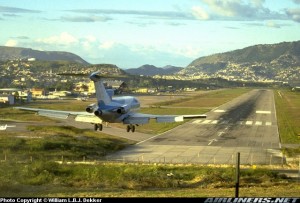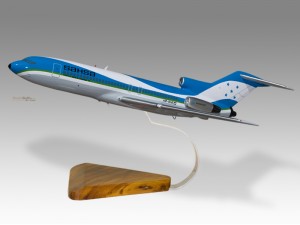Model Airplanes
I’ve been in love with airplanes from the moment I was born. The hospital in which I was born lies on the approach path for my city’s international airport. A straight line from the center of the runway’s north end to the hospital would cover about 2 miles. My mum says that after I was born I cried incessantly, and the only thing that would soothe me was the screech of aircraft as they passed overhead. My first word was “avión”, Spanish for airplane. With this in mind, it came as no surprise to my family when toy airplanes became the toys I cherished the most.

The Approach to Toncontin Airport. The hospital where I was born is about 2 miles behind where this picture was taken. Photo credit to William Decker.
I liked every kind and brand of model plane, but had a particular fondness (granted, obsession) for models of Honduras’s national carrier, SAHSA. Planes in a Honduran airline’s colors are not exactly in high demand, so there wasn’t anyone making the planes other than the airline itself. They had models custom made for them by a model maker in Miami, then used them as displays in their local offices and in travel agencies. My grandfather was a stakeholder in the airline, so armed with that and the help of my charming smile I saw to it that a considerable amount of these models found their way into my possession. Back then (early 90’s) the models should have been about 75 bucks a pop, but considering SAHSA went bankrupt in 1994 they are virtually priceless now.
Gary Cross mentions in the first paragraph of page 37 in “Modern Children, Modern Toys” (course packet page 55) that
“Toys were both vehicles to introduce the ‘real world’ and fantasy objects shut off from that world in the child’s ‘secret garden’.”
This perfectly sums up my experiences with my model planes. My playtime consisted of this: I would set up two “airports” on opposite tables across a room. I envisioned the floor as an ocean, and both the tables represented islands. I would then proceed to micromanage each “airport” using my imagination and my recollection of airport infrastructure. Each plane would “land” at an airport, then would be given time to unload its passengers on “stairs” (Honduras didn’t have jet ways at the time); the cargo would be taken to the imaginary terminal (usually a box of cereal lying flat), the jet would be refueled, new passengers loaded, then it would take off once again with the other “island” as its destination. As Cross mentioned above, I was in my own world of sorts, however I tried to make that world as similar to the real world as possible. During my playtime I did more than just mimic the real world though; I began to understand it. I realized why airplanes used radios to communicate with a control tower one day when I attempted to land one of my jets while another was just lining up with the runway for takeoff. Something that was easy for me to fix there, but would likely end in a horrifying accident in the real world. Through having a line of models waiting to unload their passengers as a result of me not balancing out the arrivals and departures, I realized why airlines’ timescales were so dependent on the efficiency of many moving parts. Keeping track of how many routes a particular plane had flown that day taught me to add. Balancing the routes flown so that all my “fleet” participated equally taught me to multiply, divide, and subtract. To quote Cross, I was learning “how to be productive through purposive play” (course packet, page 55). The creation of my own little world in which I could move all the pieces without any repercussions ultimately allowed me the freedom to understand and thus prepare for the world ahead on my terms. At least the airline world…

